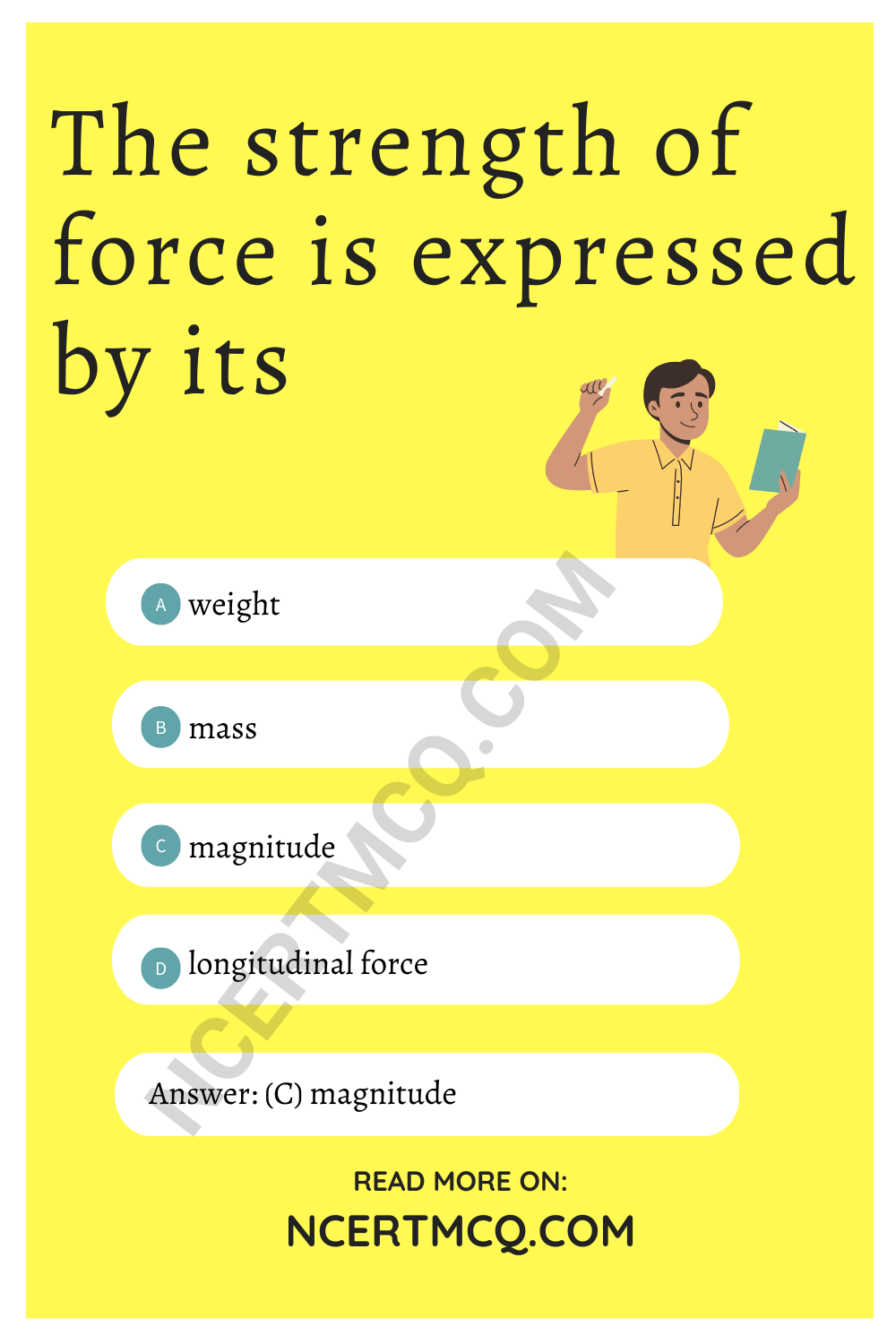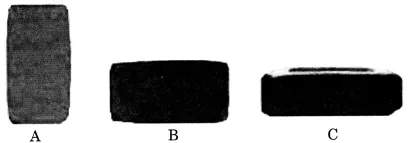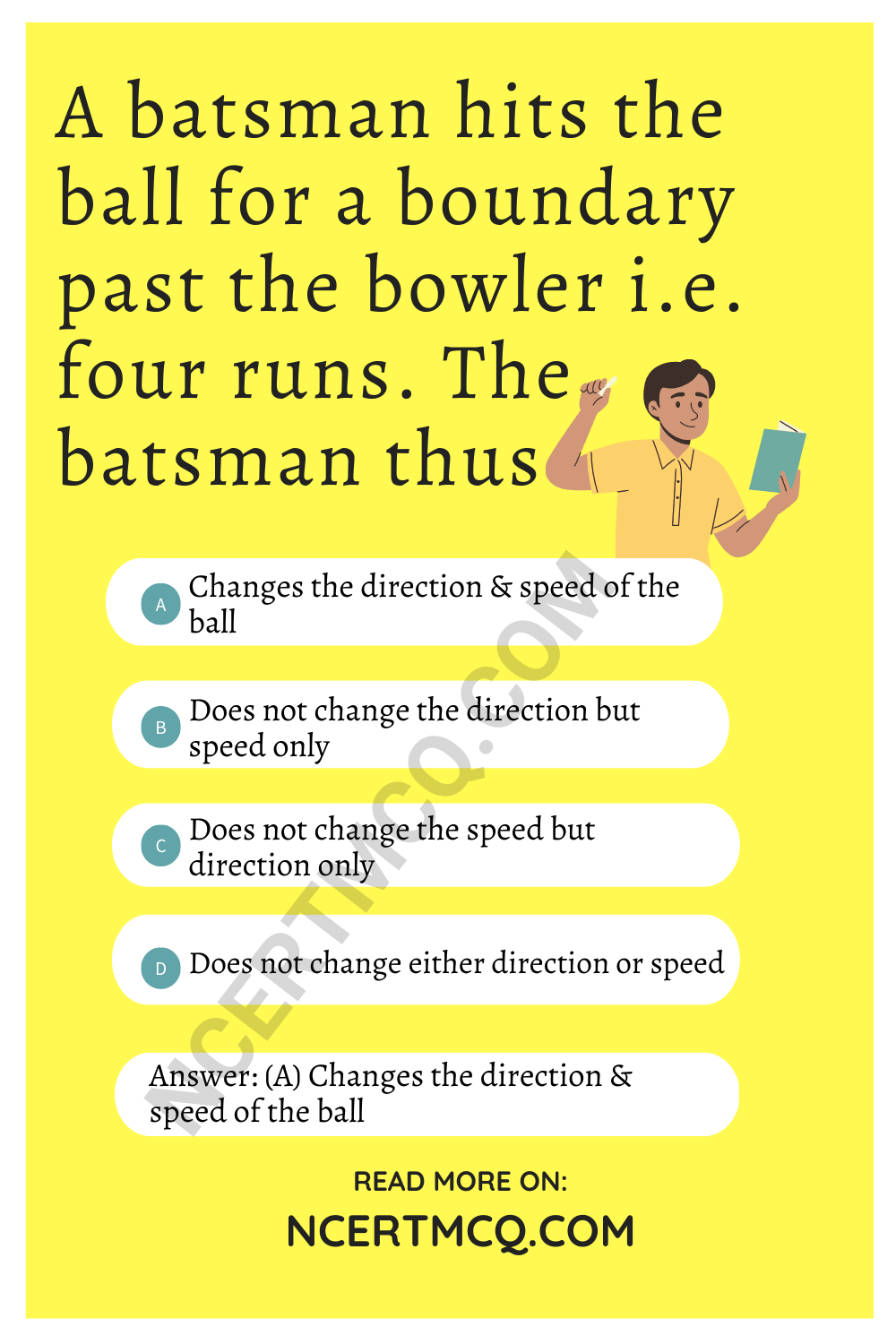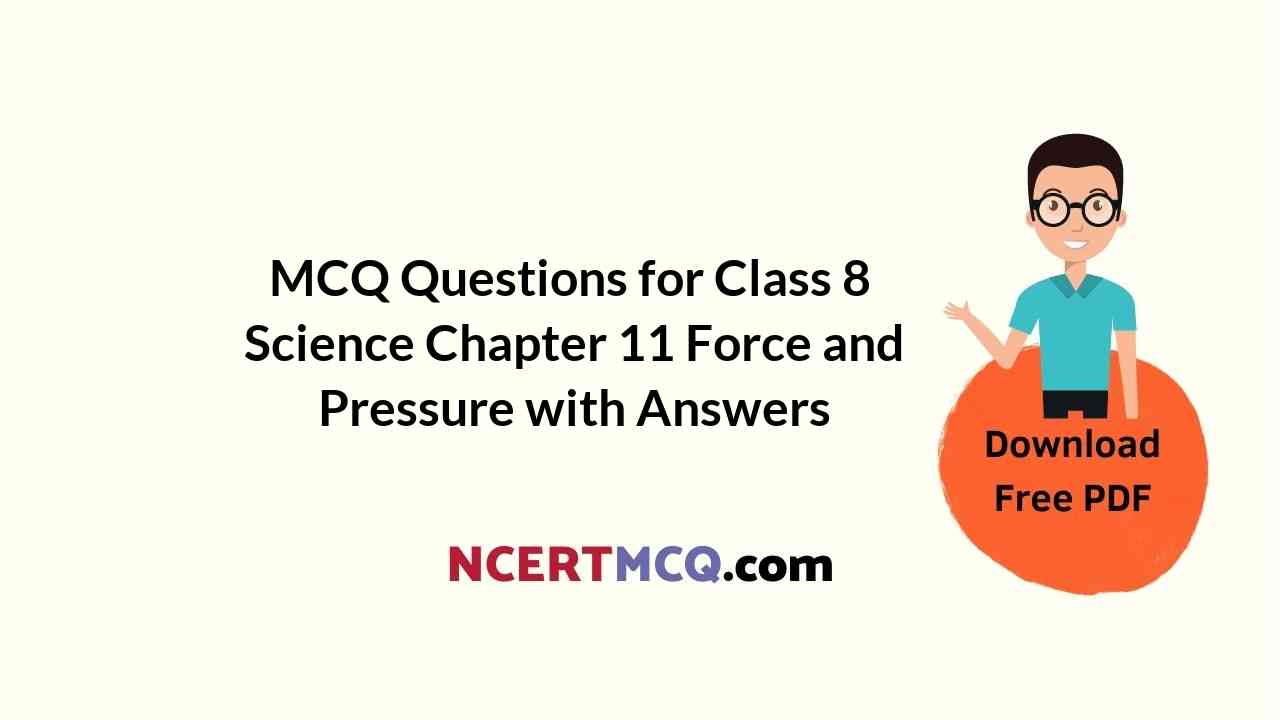Check the below Online Education NCERT MCQ Questions for Class 8 Science Chapter 11 Force and Pressure with Answers Pdf free download. MCQ Questions for Class 8 Science with Answers were prepared based on the latest exam pattern. We have provided Force and Pressure Class 8 Science MCQs Questions with Answers to help students understand the concept very well. https://ncertmcq.com/mcq-questions-for-class-8-science-with-answers/
You can refer to NCERT Solutions for Class 8 Science Chapter 11 Force and Pressure to revise the concepts in the syllabus effectively and improve your chances of securing high marks in your board exams.
Class 8 Science Chapter 11 MCQ With Answers
Science Class 8 Chapter 11 MCQs On Force and Pressure
Choose the correct option.
Force And Pressure Class 8 MCQ Question 1.
The pressure which is exerted by air around us is known as
(a) force
(b) atmospheric pressure
(c) muscular force
(d) friction
Answer
Answer: (b) atmospheric pressure
Class 8 Science Chapter 11 MCQ Question 2.
Force acting on per unit area is called
(a) non-contact forces
(b) contact forces
(c) force
(d) pressure
Answer
Answer: (d) pressure
Class 8 Force And Pressure MCQ Question 3.
A ___________ exerted by an object on another is a force.
(a) Push or pull
(b) Contact or non-contact force
(c) Pressure
(d) Magnitude
Answer
Answer: (a) Push or pull
MCQ On Force And Pressure Class 8 Question 4.
The force exerted by the earth to pull the object towards itself is called
(a) electrostatic force
(b) gravitational force
(c) muscular force
(d) contact force
Answer
Answer: (b) gravitational force
Class 8 Science Ch 11 MCQ Question 5.
Muscular force is also called ___________ force.
(a) non-contact
(b) contact
(c) gravitational
(d) magnetic
Answer
Answer: (b) contact
MCQ Of Force And Pressure Class 8 Question 6.
The force exerted by a charged body on another char
(a) gravitational force
(b) electrostatic force
(c) non-contact force
(d) contact force
Answer
Answer: (b) electrostatic force
Ch 11 Science Class 8 MCQ Question 7.
Force changes the
(a) motion of body
(b) speed of body
(c) shape of body
(d) all of these
Answer
Answer: (d) all of these
MCQ Questions For Class 8 Science Chapter 11 Question 8.
The force exerted by our muscle is called
(a) electrostatic force
(b) muscular force
(c) gravitational force
(d) non-contact force
Answer
Answer: (b) muscular force
Force And Pressure MCQ Class 8 Question 9.
1 kilogram weight is equal to
(a) 98 N
(b) 9.8 N
(c) 0.98 N
(d) 0.098 N
Answer
Answer: (b) 9.8 N
Class 8 Chapter 11 Science MCQ Question 10.
A spring balance is used for measuring
(a) mass
(b) weight
(c) pressure
(d) speed
Answer
Answer: (b) weight
Class 8 Science Force And Pressure MCQ Question 11.
Two boys A and B are applying force on a block. If the block moves towards the boy A, which one of the following statements is correct?
(a) Magnitude of force applied by A is greater than that of B.
(b) Magnitude of force applied by A is smaller than that of B.
(c) Net force on the block is towards B.
(d) Magnitude of force applied by A is equal to that of B.
Answer
Answer: (b) Magnitude of force applied by A is smaller than that of B.
Force And Pressure Class 8 MCQ With Answers Question 12.
When two forces act in opposite directions, then net force acting is the
(a) sum of two forces
(b) difference between two forces
(c) both of these
(d) none of these
Answer
Answer: (b) difference between two forces
Ncert Class 8 Science Chapter 11 MCQ Question 13.
The strength of force is expressed by its
(a) weight
(b) mass
(c) magnitude
(d) longitudinal force
Answer
Answer: (c) magnitude

MCQ Force And Pressure Class 8 Question 14.
Leaves fall down on the ground due to
(a) electrostatic force
(b) magnetic force
(c) gravitational force
(d) muscular force
Answer
Answer: (c) gravitational force
Class 8 Ch 11 Science MCQ Question 15.
State of motion is described by
(a) Position of rest
(b) Position of motion
(c) Both by the state of rest or motion
(d) None of these
Answer
Answer: (c) Both by the state of rest or motion
Question 16.
When the hammer strikes the gong of an electric bell, which of the following force is responsible for the movement of hammer?
(a) Gravitational force alone
(b) Magnetic force alone
(c) Electrostatic force alone
(d) Frictional force alone
Answer
Answer: (c) Electrostatic force alone
Question 17.
During dry weather, while combing hair, sometimes we experience hair flying apart. The force respon¬sible for this is
(a) force of gravity
(b) force of friction
(c) electrostatic force
(d) magnetic force
Answer
Answer: (c) electrostatic force
Question 18.
A container is filled with water as shown in the given figure. Which of the following statements is correct about pressure of water?

(a) Pressure at A > Pressure at B > Pressure at C
(b) Pressure at A = Pressure at B = Pressure at C
(c) Pressure at A < Pressure at B > Pressure at C
(d) Pressure at A < Pressure at B < Pressure at C
Answer
Answer: (d) Pressure at A < Pressure at B < Pressure at C
Question 19.
Two objects repel each other. This repulsion could be due to
(a) frictional force only
(b) electrostatic force only
(c) magnetic force only
(d) either a magnetic or an electrostatic force
Answer
Answer: (d) either a magnetic or an electrostatic force
Question 20.
Which one of the following forces is a contact force?
(a) Force of gravity
(b) Magnetic force
(c) Force of friction
(d) Electrostatic force
Answer
Answer: (c) Force of friction
Question 21.
A brick is kept in three different ways on a table as shown in given figure. The pressure exerted by the brick on the table will be

(a) maximum in position A
(b) maximum in position C
(c) maximum in position B
(d) equal in all cases
Answer
Answer: (a) maximum in position A
Question 22.
A push or pull on an object is called
(a) Pressure
(b) Push-pull
(c) Force
(d) All of the above
Answer
Answer: (c) Force
Question 23.
If two forces act in the opposite directions on an object, the net force acting on it is the
(a) Sum of the two forces
(b) difference between the two forces
(c) Multiplication of the two forces
(d) Division of the two forces
Answer
Answer: (b) difference between the two forces
Question 24.
Which of the following is proper example(s) to explain that force on an object may change its shape
(a) A ball of dough rolled into chapati
(b) Pressing a rubber ball kept on table
(c) Making model using clay
(d) All of the above
Answer
Answer: (d) All of the above
Question 25.
A ball rolling on the ground slows down and finally stops. This is because of
(a) Force
(b) Less force applied
(c) Friction
(d) None of the above
Answer
Answer: (c) Friction
Question 26.
Force of friction always acts on moving objects and its direction shall be ____
(a) On any direction
(b) Along the direction of motion
(c) Perpendicular to the direction of motion
(d) Opposite to the direction of motion
Answer
Answer: (c) Perpendicular to the direction of motion
Question 27.
If In a tug-o-war, when two teams are pulling a rope, and the rope does not move towards any team, it implies that
(a) Equal force is being applied in the same direction
(b) Equal Force is being applied in opposite direction
(c) No force is applied in any direction
(d) Cannot be explained
Answer
Answer: (b) Equal Force is being applied in opposite direction
Question 28.
An example of a non- contact force is
(a) Force exerted by us to lift a bucket
(b) Push a stationary car
(c) Force exerted by magnet
(d) Hit a cricket ball for a 6 run
Answer
Answer: (c) Force exerted by magnet
Question 29.
Pressure =
(a) Area / force on which it acts
(b) force / area on which it acts
(c) Volume / force on which it acts
(d) Force / volume on which it acts
Answer
Answer: (b) force / area on which it acts
Question 30.
Gravity is
(a) Repulsive
(b) Attraction + Repulsive force
(c) Attractive force
(d) Not a force
Answer
Answer: (c) Attractive force
Question 31.
A batsman hits the ball for a boundary past the bowler i.e. four runs. The batsman thus
(a) Changes the direction & speed of the ball
(b) Does not change the direction but speed only
(c) Does not change the speed but direction only
(d) Does not change either direction or speed
Answer
Answer: (a) Changes the direction & speed of the ball

Match the items given in column I suitably with those given in column II.
| Column I | Column II |
| 1. Pressure | (a) Fluid pressure |
| 2. Barometer | (b) Unit of pressure |
| 3. Newton | (c) Non-contact force |
| 4. Manometer | (d) Force/Area |
| 5. Pascal | (e) Unit of force |
| 6. Magnetic force | (f) Net force acting on a body |
| 7. 1 kilogram | (g) Atmospheric pressure |
| 8. Resultant force | (h) 9.8 N |
| 9. Frictional force | (i) Down the column |
| 10. Pressure increases | (j) Contact force |
Answer
Answer:
| Column I | Column II |
| 1. Pressure | (d) Force/Area |
| 2. Barometer | (g) Atmospheric pressure |
| 3. Newton | (e) Unit of force |
| 4. Manometer | (a) Fluid pressure |
| 5. Pascal | (b) Unit of pressure |
| 6. Magnetic force | (c) Non-contact force |
| 7. 1 kilogram | (h) 9.8 N |
| 8. Resultant force | (f) Net force acting on a body |
| 9. Frictional force | (j) Contact force |
| 10. Pressure increases | (i) Down the column |
Fill in the blanks with suitable word/s.
1. We ___________ the bucket to take out water from well.
Answer
Answer: pull
2. The strength of a force is usually expressed by its ___________.
Answer
Answer: magnitude
3. ___________ force is the force resulting due to the action of muscles.
Answer
Answer: Muscular
4. The envelop of air all around us is called ___________.
Answer
Answer: atmosphere
5. To open a door we or ___________ the door.
Answer
Answer: push, pull
6. Force of friction is an example of ___________ force.
Answer
Answer: contact
7. Force ___________ is called pressure.
Answer
Answer: per unit area
8. Force has ___________ as well as direction.
Answer
Answer: magnitude
9. Fruits fall ___________ due to the force of gravity.
Answer
Answer: downward
10. The body at rest is called ___________ body.
Answer
Answer: stationary
11. ___________ and ___________ forces are the two kinds of forces.
Answer
Answer: Contact, non-contact
12. Force exerted by magnet is called ___________ force.
Answer
Answer: magnetic
13. We apply force on ___________ while walking.
Answer
Answer: ground
14. Force is ___________ to pressure.
Answer
Answer: directly proportional
15. The ___________ is measured by an instrument called barometer.
Answer
Answer: atmospheric pressure
State whether the given statements are true or false.
1. Force applied on an object in opposite directions add to one another.
Answer
Answer: False
2. Pressure does not depend on area of contact.
Answer
Answer: False
3. A force can change the state of motion of an object.
Answer
Answer: True
4. Force cannot change the speed of an object.
Answer
Answer: False
5. Atmospheric pressure is less at higher altitudes.
Answer
Answer: True
6. Force of gravity is a contact force.
Answer
Answer: False
7. Muscular force is also known as contact force.
Answer
Answer: True
8. Pascal is the unit of force.
Answer
Answer: False
9. To move an object faster it has to be pushed or pulled repeatedly.
Answer
Answer: True
10. Magnitude is the strength of force.
Answer
Answer: True
11. Force can change the shape of an object.
Answer
Answer: True
12. At least two objects must interact for a force to come into play.
Answer
Answer: True
13. Magnetic force is a non-contact force.
Answer
Answer: True
14. An apple from a tree falls on the ground due to the force of gravity.
Answer
Answer: True
15. Newton is the unit of force.
Answer
Answer: True
We hope the given NCERT MCQ Questions for Class 8 Science Chapter 11 Force and Pressure with Answers Pdf free download will help you. If you have any queries regarding Force and Pressure CBSE Class 8 Science MCQs Multiple Choice Questions with Answers, drop a comment below and we will get back to you soon.
Class 8 Science MCQ:
- Crop Production and Management Class 8 MCQ
- Microorganisms: Friend and Foe Class 8 MCQ
- Synthetic Fibres and Plastics Class 8 MCQ
- Materials: Metals and Non-Metals Class 8 MCQ
- Coal and Petroleum Class 8 MCQ
- Combustion and Flame Class 8 MCQ
- Conservation of Plants and Animals Class 8 MCQ
- Cell Structure and Functions Class 8 MCQ
- Reproduction in Animals Class 8 MCQ
- Reaching the Age of Adolescence Class 8 MCQ
- Force and Pressure Class 8 MCQ
- Friction Class 8 MCQ
- Sound Class 8 MCQ
- Chemical Effects of Electric Current Class 8 MCQ
- Some Natural Phenomena Class 8 MCQ
- Light Class 8 MCQ
- Stars and the Solar System Class 8 MCQ
- Pollution of Air and Water Class 8 MCQ
